Why so many content marketing teams try creating content without investing the time and energy into in-depth content briefs?
Creating and publishing content is one of those things that is more complicated than it seems at first glance.
Any number of things can go wrong.
Expectations, goals, and success measurements may be unclear. The target audience might not be well-defined. Key topics might be left unaddressed. Important SEO factors may be missed.
The list goes on and on.
This is where content briefs come in.
They give your team clear guidance on what to write and how to write it. Ultimately, content briefs can make or break the content creation process.
Read on to learn what content briefs are and why they’re so important for you SEO.
We will also share how to create effective briefs by including 15 elements to provide great information to your content writer.
Finally, we also share content briefs templates and examples.
Table of Contents
What’s a Content Brief?
A content brief is a document that provides guidance to content creators, outlining the key points that should be covered in a piece of content.
It serves as a roadmap.
An effective content brief can guide the creation of any type of content, including blog posts, ebooks, white papers, reports, etc.
The goal of a content brief is to ensure that all stakeholders are on the same page regarding what needs to be covered in a piece of content.
Providing clear guidance upfront helps avoid misunderstandings and reduces editing time down the line.
Content briefs also ensure that the content strategy is executed properly.
Content briefs are used by different roles in an organization, but three prominent types of users are:
- Content Managers: Managers overseeing the content production process have a direct interest in consistency of output and quality control. Content briefs are useful to ensure both.
- SEOs: Individuals responsible for SEO use content briefs to ensure that the content plan is going to appeal to Google. Content briefs often include target topics, keywords, related keywords, and frequent questions to be covered in the content. They can also include the H1, URL, as well as a content outline that’s aligned with the most popular content in Google.
- Content Writers: Content writers (both experienced writers and first-time freelancers) use content briefs to ensure they cover a topic comprehensively in a way that will appeal to the target audience. The brief helps them to hit the most important talking points related to the topic. The brief will often outline the target audience, tone of voice, target length, content outline, key points that need to be addressed, and suggested resources for citations.
Why Are Content Briefs Important?
Content briefs provide a number of key benefits that make them invaluable tools for marketers and content writers.
Save Time
Content briefs cut down on wasted time.
By providing clear guidance on what needs to be covered, content creators can avoid going down rabbit holes or spending time on unnecessary tangents.
This is especially important when working with a team of writers and editors, as it ensures that everyone is on the same page and working towards the same goal.
They also help save time by ensuring that everyone is aligned on the content structure and overall expectations. This minimizes the amount of back and forth throughout the creation process.
If you use a content brief generator such as thruuu, you can reduce the brief creation time drastically. On average, thruuu can slash your content brief development time by 80% or 90%.
Content Briefs Strengthen Your Content Marketing
To be successful, content marketing should have a documented strategy in place, with well-defined goals.
Content briefs help to support these efforts by providing guidance on what needs to be covered in a piece of content. Specific points and target keywords can be highlighted.
This helps to ensure that all the necessary points are hit, and that the content is aligned with the larger marketing goals.
In addition, content briefs help improve the overall quality of content.
By providing clear guidance upfront, it ensures that content creators better understand what is expected of them. This leads to higher-quality content that is more likely to resonate with readers.
Stronger SEO Results
Achieving strong SEO results takes strategic action.
You should conduct keyword research and analyze the Google search engine results pages (SERPs) in advance.
In addition, you should apply the right headings and structure your content in a way that’s directly in line with search intent.
Content briefs help to support these efforts by providing guidance on target keywords and topics, highlighting relevant questions being asked by the target audience, and outlining the headings and subheadings throughout the content piece.
Including this information upfront helps to ensure that writers create content that is SEO-friendly, leading to stronger organic search results.
Improved Content Marketing Workflows
Content briefs can also help to improve content marketing workflows.
By having all the key information upfront, it helps to streamline the creation process. There is no need to constantly go back and forth with stakeholders for clarification on direction.
In addition, content briefs are a useful organizational anchor for your content team. Content briefs can be used as a reference point throughout the content creation process.
This helps to keep everyone on track, organized, and in alignment.
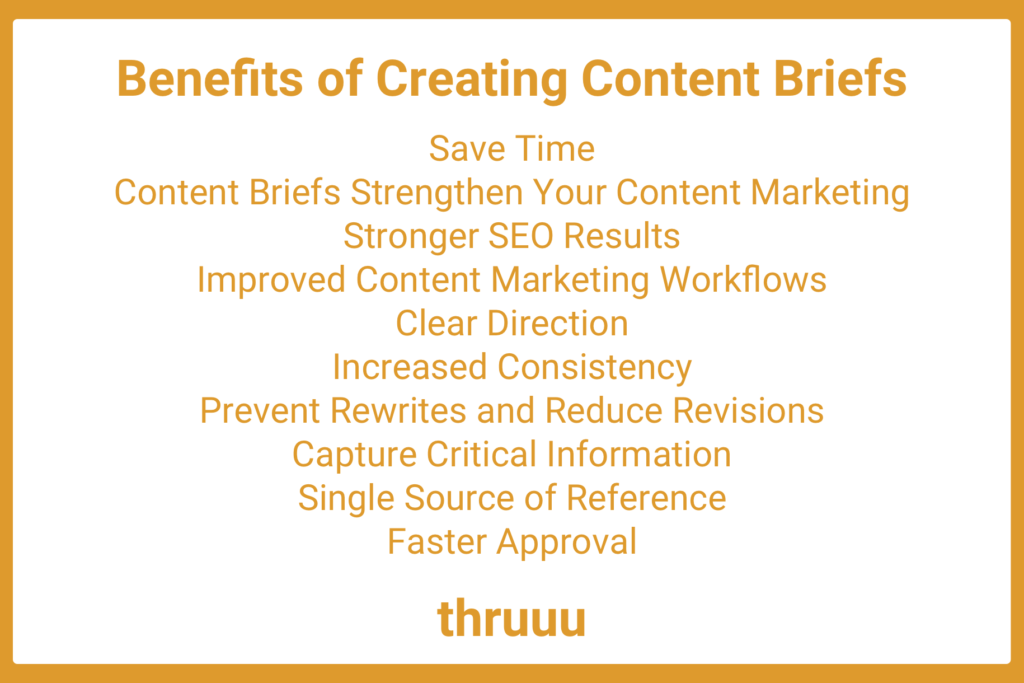
Clear Direction
The goal of a content brief is to get clear direction and approval upfront from all parties involved.
This helps to avoid any confusion, misunderstanding, or frustration later in the process.
It also allows for a smoother process overall, as it reduces or eliminates questions later in the cycle. Everyone knows what is expected of them.
Increased Consistency
A lack of consistency is a problem that often plagues marketers and content creation teams.
Content briefs help to ensure that all content pieces are consistent in approach with one another.
This supports the overall branding of a company and delivers a better user experience for site visitors going from post to post.
It can also assist with search engine optimization (SEO).
In terms of branding, consistency helps to create a cohesive image that readers can easily recognize. It also makes it easier for potential customers to remember a company and its products or services.
In terms of SEO, consistency helps to signal to search engines what a website is about. This, in turn, can lead to higher rankings for relevant keywords.
Also, a major benefit of consistency is that the content creation process becomes repeatable and gets easier for everyone involved.
This makes the process more efficient over time.
Prevent Rewrites and Reduce Revisions
Content briefs can also help to prevent rewrites and reduce revisions.
By having all the key information upfront, it minimizes the need for guessing.
This leads to fewer misunderstandings, edits, and revisions. This also leads to happier writers!
In addition, having a content brief in place helps to reduce the risk of errors.
By having a clear understanding of what is needed, it minimizes the chance of making mistakes. This, in turn, leads to fewer rewrites and a smoother overall process.
Capture Critical Information
Creating detailed, high-value content is no simple task. But an effective content brief makes it much simpler.
You probably have many important points you want to communicate to your writer. For example:
- Target audience segment or buyer persona
- Content outline
- Topics or questions to cover
- Primary keyword and associated Google search volume
- Related keywords
- Search intent
- Target word count
- Subtopics
- Comments or additional guidance on particular headings or subheadings
- CTAs
- Reference material
- Citations to high-quality sources, etc.
In your briefs, include all critical pieces of information that will help the writer succeed.
Single Source of Reference
Without a single, unified reference point, the content creation process can quickly go astray.
One person may think one topic should be included, while another may think that a completely different topic should be covered.
One team member may believe that you’re going in one direction on the angle to take, while another has a distinctly different notion.
All of this can lead to frustration and wasted time as team members try to figure out how to course correct on the fly.
A content brief helps to prevent this by providing a single source of reference for the entire team. By having all the key information in one place, it ensures that everyone is on the same page.
Faster Approval
Finally, content briefs usually result in faster approvals at each stage of the creation process.
If the directions of the brief were followed correctly, there should be little back and forth required.
Everything from creating the initial outline to the final revisions should be relatively pain-free and smooth.
From Hours to Minutes
Generate effective content briefs within 10 minutes with thruuu’s powerful Content Brief Generator.
What Should a Content Brief Include?
There are no hard and fast rules about what should be included in a content brief.
Your marketing goals, content strategy, audience, and industry, along with the SERP landscape, influence what should make it into each brief respectively.
That being said, here are some common elements that effective briefs often include.
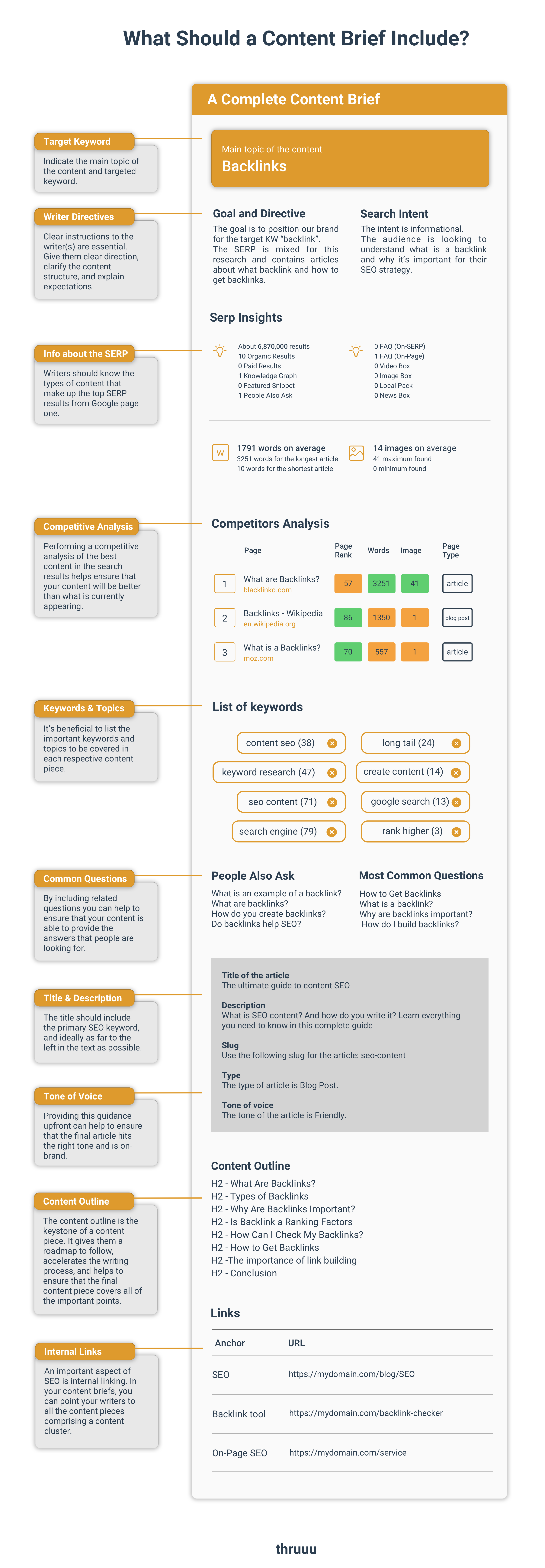
Writer Directives
Clear instructions to the writer(s) are essential.
After all, they are the ones tasked with creating the content. If you want them to produce great work, give them clear direction, clarify the content structure, and explain expectations.
You should explain the objectives of the content and share editorial guidelines with the writers.
Target Audience
You want to include things like the target audience segment and any defined personas.
This is one of the most critical aspects of effective writing — knowing specifically who you’re writing for.
Search Intent and Customer Journey
Beyond answering the “Who”, your content team should know why the audience is interested in consuming the content (=search intent).
They should know where they are in the customer journey.
And they should be aware of the actions you want the audience to take as a result of reading the piece, as outlined by Nia Gyant:
Unique Perspectives
A content brief should support the writer in creating a piece of content with a unique angle or other added value for the reader.
It’s not enough to simply write content that’s similar to what’s performing well in Google.
Your content team’s job today is to go beyond the current baseline and to provide something new, something additional, and something unique.
This is now especially important since the Google Helpful Content Update of August 2022.
An effective way to identify a unique angle for your content piece is, as Shobha Ponnappa points out, to analyze content gaps via five different measures:
To get ideas for new angles and fresh perspectives, you can use the Content Analysis Tool tool of thruuu.
The tool analyzes the top-ranking pages and shares information and provides content ideas that are not yet covered by your competitors.
This information can also be included in your content brief.
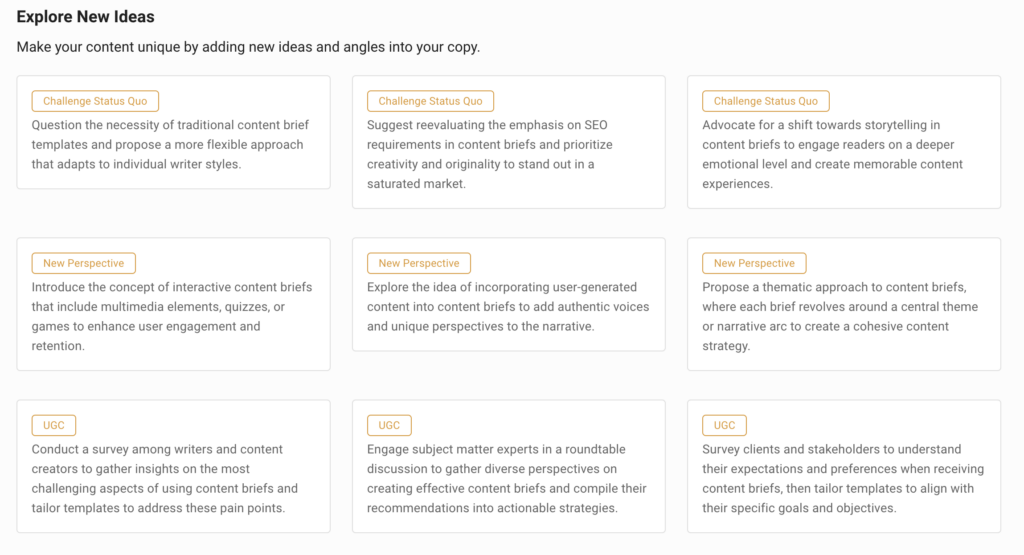
Information about the SERP
Writers should know the types of content that make up the top SERP results from Google page one.
This information provides them with a guide for what to include in a content piece in order for Google to deem it relevant and aligned with search intent.
The types of SERP information that can be helpful in a content brief include:
- SERP features (videos, local three pack, PAA, etc.)
- Average word count for the top 10 Google results
- Average word count for the top 3 results
- Presence of video, images, local pack, or other features in the SERP
- Headings
- PAA questions
- Questions being asked online overall
- Common terms appearing throughout the content pieces on page one
- Related terms
The goal is not to copy the top search results.
Rather, the goal is to understand search intent in the eyes of Google. In other words, what is Google striving to provide to searchers of a given query?
If you reverse engineer the Google SERP, you know exactly what Google believes to be best aligned with intent.
A SERP analysis, such as with a tool like thruuu, provides you with a wealth of SERP data in a single click.
Here is what a SERP analysis from thruuu looks like in the initial dashboard:
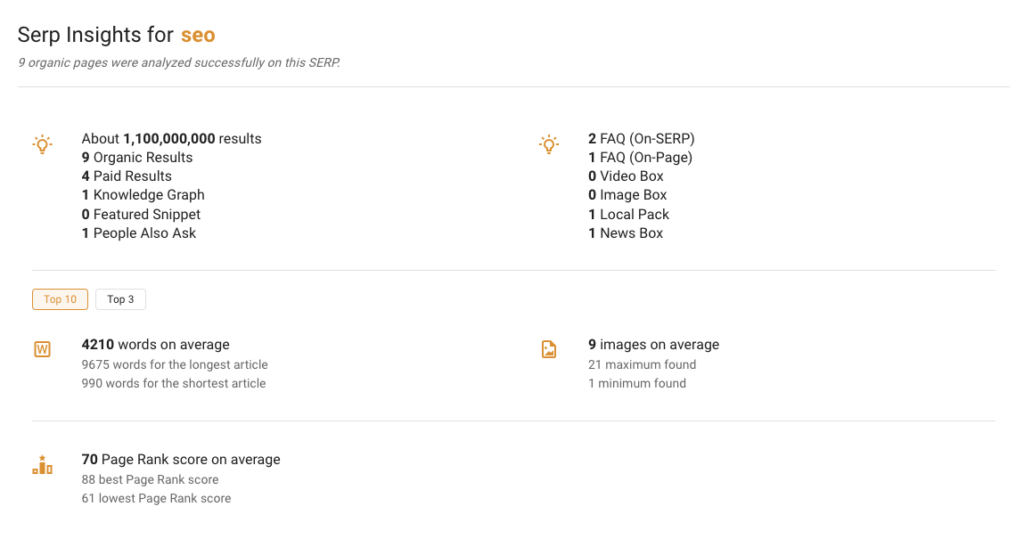
Competitive Analysis
Performing a competitive analysis of the best content in the search results helps ensure that your content will be better than what is currently appearing.
Your competitive analysis should include the following reviews of the top-ranking content in Google:
- Topics/keywords included in competitors’ content
- Page type (web page, blog post, article, etc.)
- Title tags
- Meta descriptions
- H1
- Outline of the headings and subheadings on each page listed in the SERP
- Length of content
- Types of content (images, videos, etc.)
This will help you to identify any gaps in the existing content and make sure that your content is able to fill those gaps.
Here are two different views of a competitive analysis in thruuu:
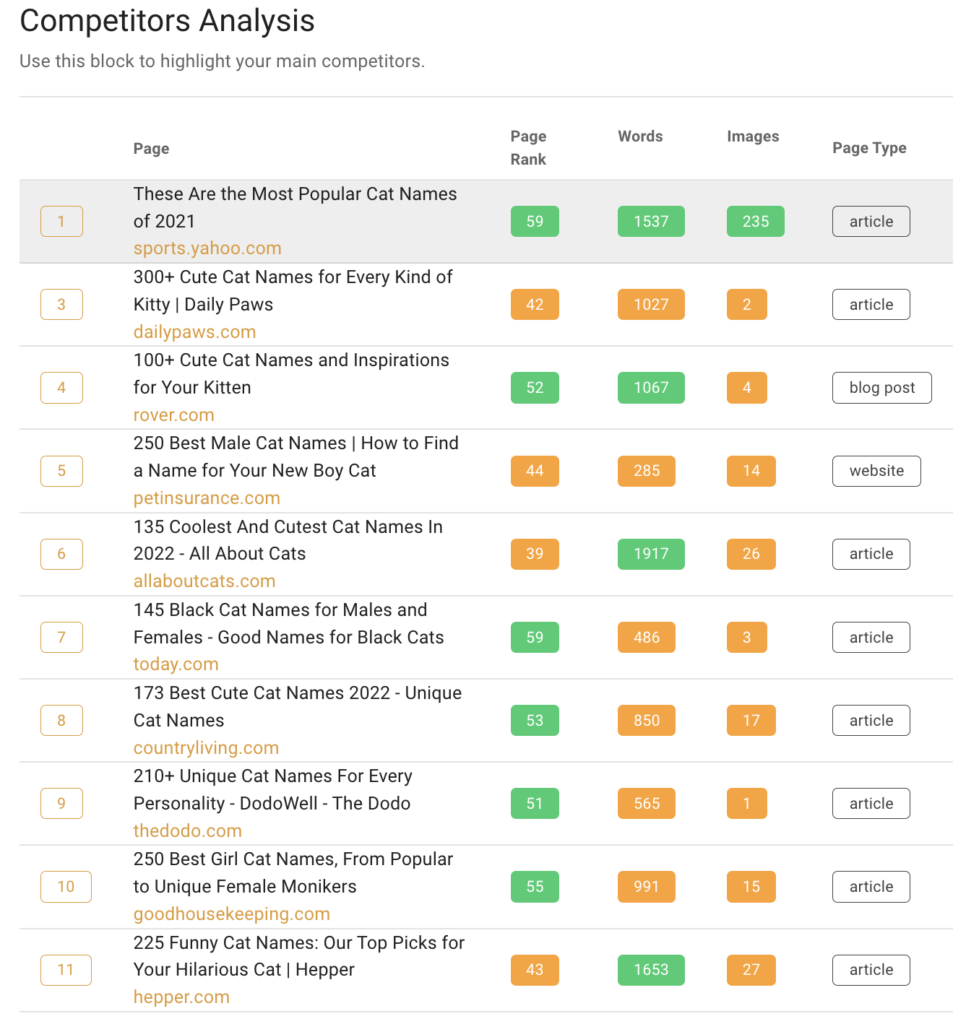
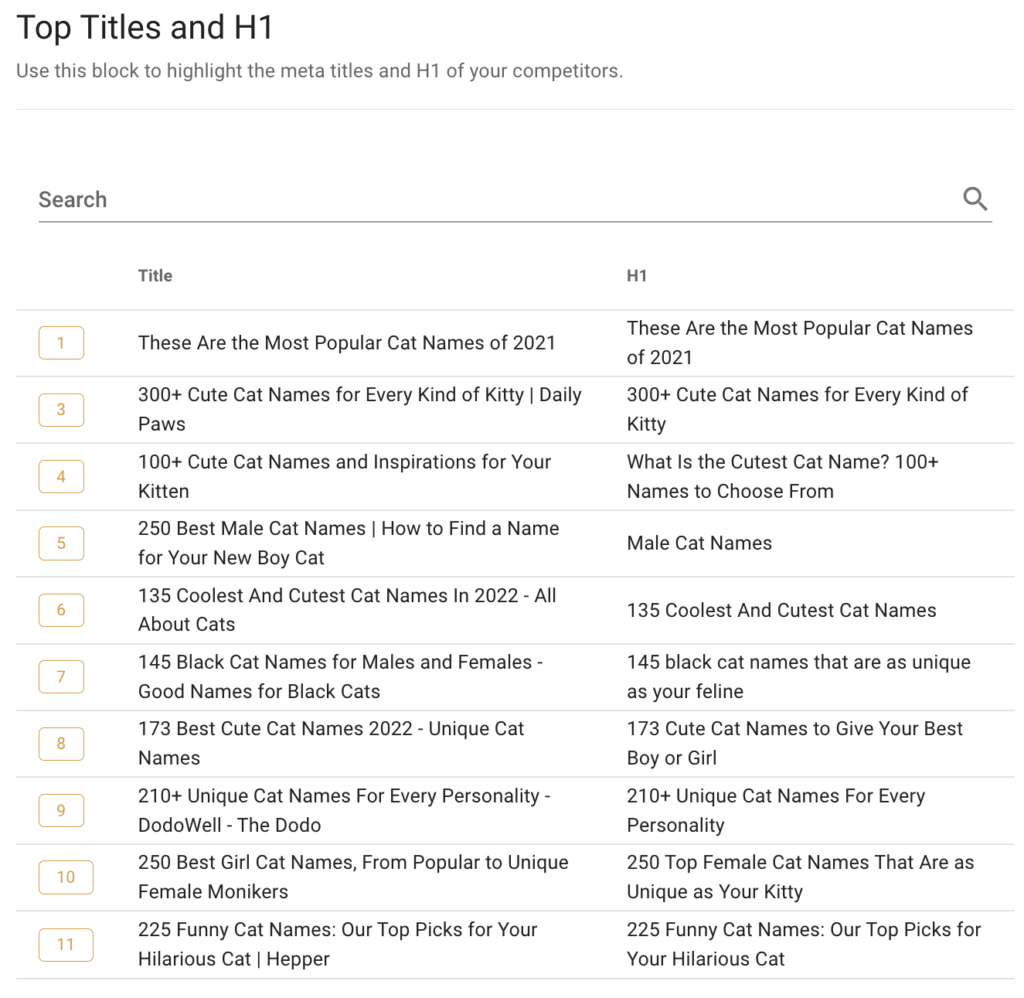
Most Common Questions being Asked Online
A large percentage of queries in Google are simply questions.
This is especially true for informational searches. People are looking for answers to their questions and your content should be able to provide those answers.
By including related questions in your content briefs, you can help ensure that your content provides the answers people are looking for.
In addition, optimizing your content to answer your audience’s questions helps you to be added to the PAA (People Also Ask) boxes in the Google SERP. This gives you an opportunity to capture more real estate in the SERPs.
thruuu makes it simple to see the questions being asked online related to specific topics:
Jonas Sickler suggests that beyond the most common questions, you should also define the previous question and the next question in the reader’s journey:
Primary Keyword & Secondary Topics
In your content briefs, it’s beneficial to list the important keywords and topics to be covered in each respective content piece.
This of course includes the primary keyword.
Just as importantly, you should document any related secondary keywords that are appearing often in the ranking content for the primary keyword.
For example, for the query “cat names,” many of the listings in Google include the phrase “cute cat names” and “popular cat names”.
Looking more granularly, “luna” and “milo” appear multiple times in the top SERP listing, and so may be worth considering for your piece, as well.
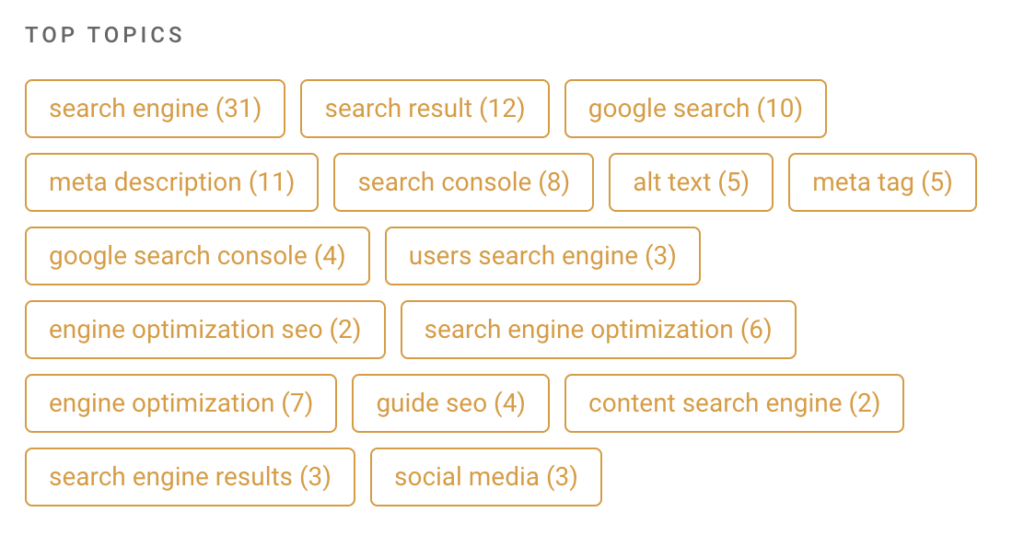
Additional Resources
Providing writers with additional resources, such as related articles, can inspire them and spark new ideas to incorporate into the content.
In addition, if these are often cited among the Google top 10, it’s a good indication that Google may be expecting to see the citation in anything deemed relevant to the query.
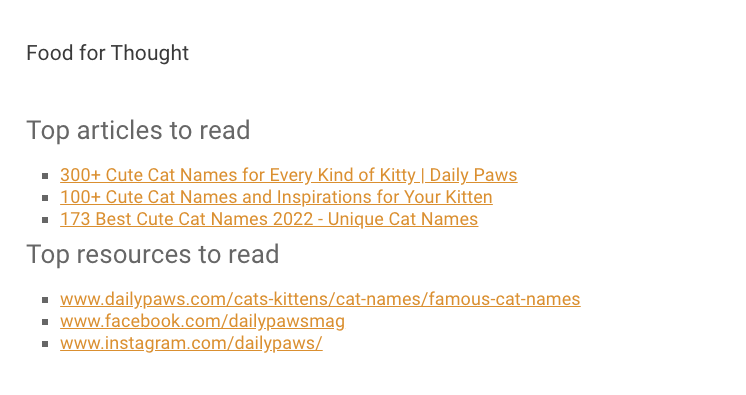
Inspirational resources can run the gamut, including:
- Stories
- Links to similar articles
- Related videos
- Podcast episodes
- Interviews with industry leaders or experts
- Recent news
- Survey data
- Case studies
- Quotes
- Etc.
Better Content Briefs. Faster.
Generate effective content briefs within 10 minutes with thruuu’s powerful Content Brief Generator.
SEO Title and Description
Your content brief should also include the title and meta description for each of the listings on Google page one.
This acts as guardrails for the writer, so that they understand the type of content that Google is looking for.
The title should include the primary SEO keyword, and ideally as far to the left in the text as possible.
The meta description does not need to include the keyword necessarily but instead should be focused on attracting clicks.
Both should accurately reflect the content of the article. This can be a difficult balance to strike, but it’s important to get it right in order for your content to perform well and to deliver a good experience for the searcher.
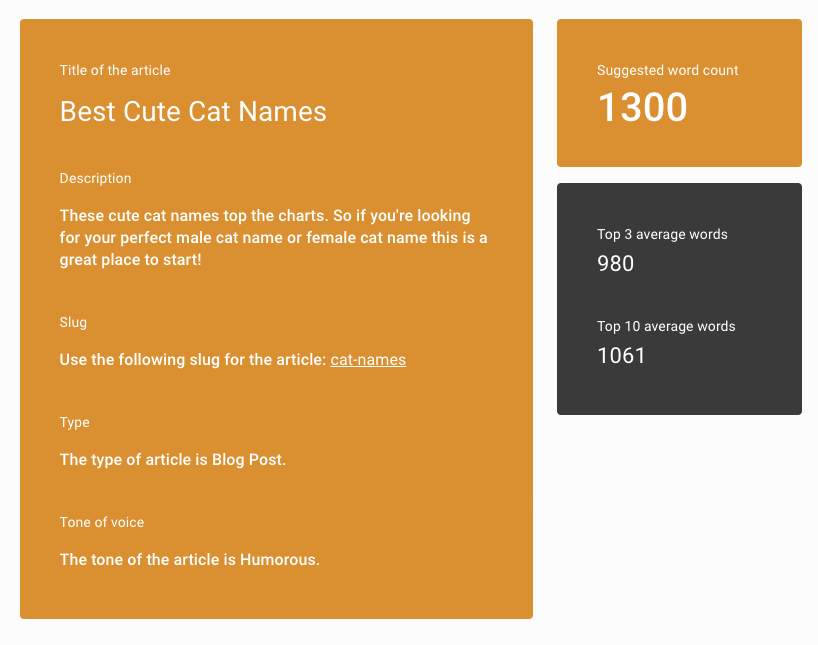
Tone of Voice
The tone of voice is an important element in any piece of corporate writing.
When creating a content brief, it’s helpful to include the desired tone of voice for the brand.
Should it be conversational? Authoritative? Formal? Humorous? Motivating?
Providing this guidance upfront can help to ensure that the final article hits the right tone and is on-brand.
If the tone of voice is specified in a brand style guide, simply provide a link within the brief.
Content Outline
The content outline is the keystone of a content piece. Providing an outline for the content is enormously helpful for writers.
It gives them a roadmap to follow, accelerates the writing process, and helps to ensure that the final content piece covers all of the important points.
This is a great way to ensure that the flow of the piece is compelling, while making sure that Google will find it to be highly relevent.
Your content outline should include a list of all the headings as well as any sub-topics.
It’s helpful to include additional resources here, such as links to articles or videos.
And you can specify any stories, case studies, pain points, talking points, etc. that should be highlighted within a given heading or sub-topic.
In your content outline, clearly mark each heading as H1, H2, H3, or H4, etc.
Next to each item in the content outline in your content brief, include any notes, guidance, or special instructions for the content writer to tee the writer up for greater success.
Internal Links & External Links
An important aspect of SEO is internal linking. In your content briefs, you can point your writers to all the content pieces comprising a content cluster.
You can instruct them to include links to the pillar page. Beyond the pillar, you can ask them to link to the various cluster pages, as mentioned by Luca Fancello, SEO Consultant.
All of this internal linking strengthens signals to Google as to your authoritativeness on the topic.
This relates to both the broader topic covered by the cluster overall as well as the specific topic of your new content piece.
Visuals
Specify any visuals that should be included in the content.
This can include things like screenshots, infographics, photos, videos, etc.
If any visuals need to be designed, make sure to coordinate with the designer so that they have sufficient time.
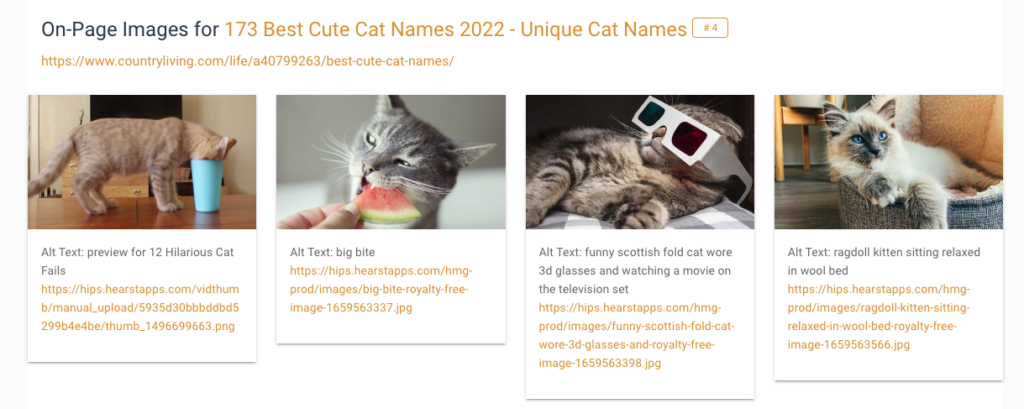
Calls-to-Action (CTAs)
Your content should always have at least one call-to-action (CTA).
This could be something like subscribing to a mailing list, downloading a white paper, or making a purchase.
Whatever the CTAs, make sure they are included in the content brief.
Each CTA should be clear and concise. It should also be relevant to the content piece.
For example, if the article is about content marketing, then a CTA to sign up for a content marketing course would be appropriate.
Test adding multiple CTAs to the page. Different readers will respond to different CTAs. Give yourself a better shot at a conversion by mixing it up and offering them different options.
Start with a Content Brief template
Creating content briefs from scratch each time can be time-consuming when you’re trying to scale your content production.
Using a content brief template significantly reduces the amount of time and effort required to create briefs when they should all follow a certain framework.
You can simply start with the template and then customize it based on the topic each time.
This can save your team literally hundreds of hours each year.
thruuu makes it simple to create not only detailed content briefs, but content brief templates for content scaling.
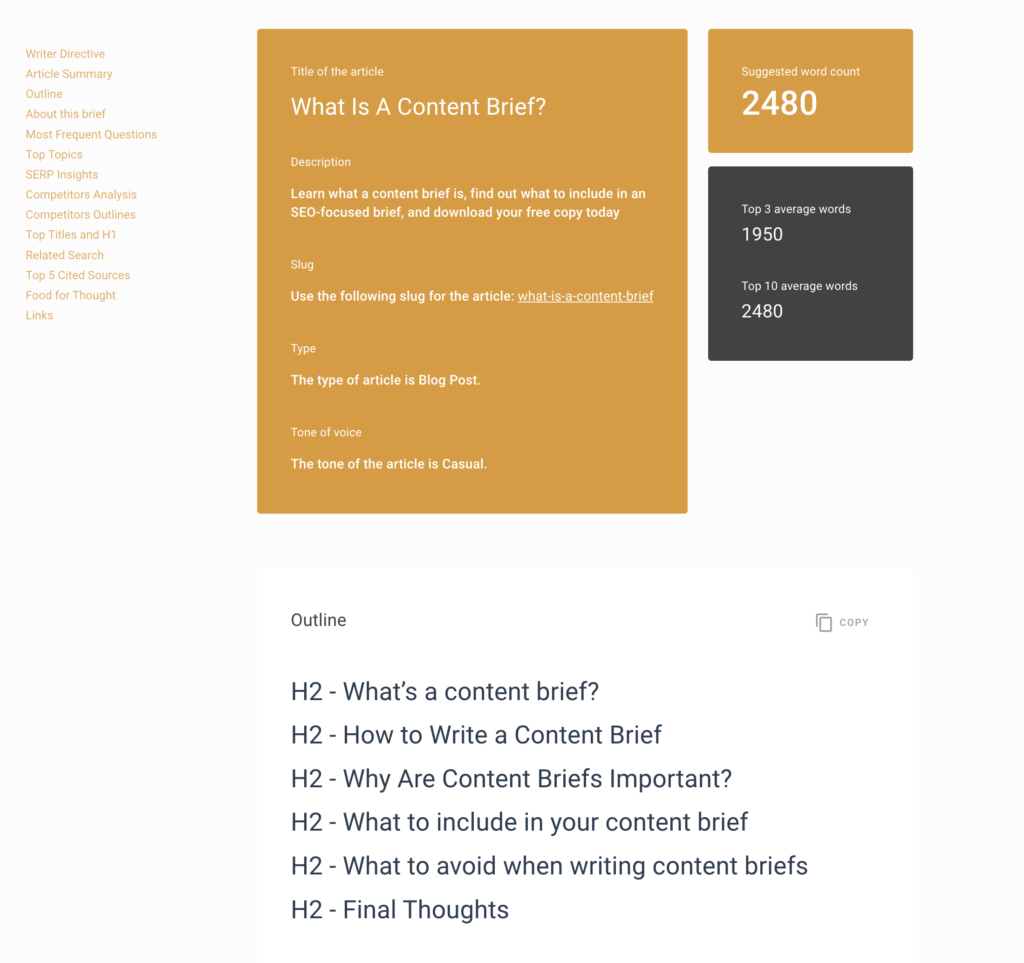
Click to see this thruuu Content Brief
With thruuu, information from the SERPs is automatically pulled into the briefs based on a given keyword.
Flexibly create your own content brief templates and select the specific elements you value most (from a library of elements).
You can adjust the order and customize each template in line with the needs of a specific account, client, website, project, etc.
The end result is a powerful framework for the efficient output of thorough content briefs.
Download a Content Brief Template
Examples of Content Briefs
Are you looking for examples of content briefs and additional templates?
You can visit our content brief template library where you will find:
Content Brief Template for a Blog Post: This SEO Content Brief Template is ideal for website owners looking to optimize their blog posts.
Content Brief Template for B2B SaaS Blog: This blog post Content Brief Template is ideal for B2B companies seeking to increase traffic.
Content Brief Template for Outsourcing Content Writers: This SEO Content Brief template is ideal for content teams that work with outsourced writers.
For every templates you will also find a Word and GDoc version.
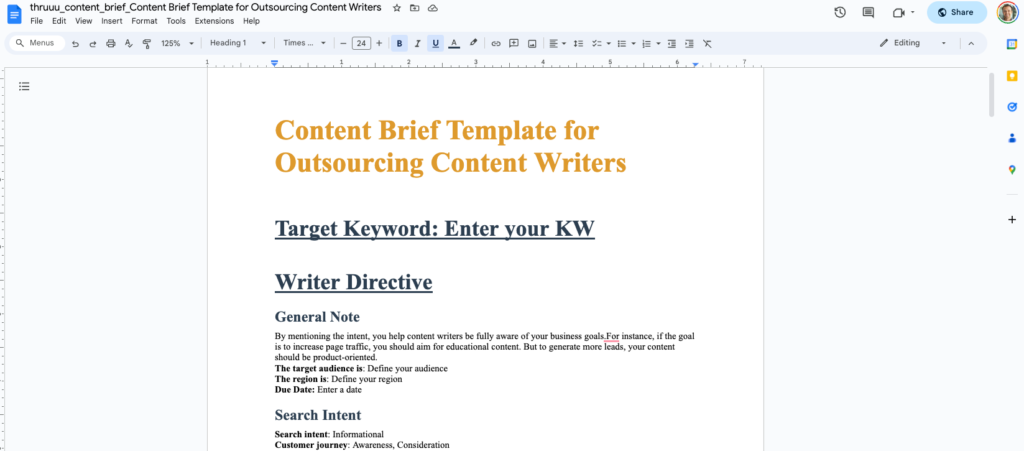
Create a Content Brief in 5 steps with our AI Content Brief Generator
Now that you understand what a content brief is and what information you could include in this document, we would like to give you some insights about our Content Brief Generator.
Our tool extracts real-time data from Google Search, provides great brief templates, and leverages AI to accelerate the content brief creation process.
And on top of that, you can get started for free.
Step 1 – Enter your Target Keyword and Audience
To get started with the thruuu content brief generator, hit the “BRIEF” button and enter:
- Your target keyword
- How your audience will search for the content (country and search engine)
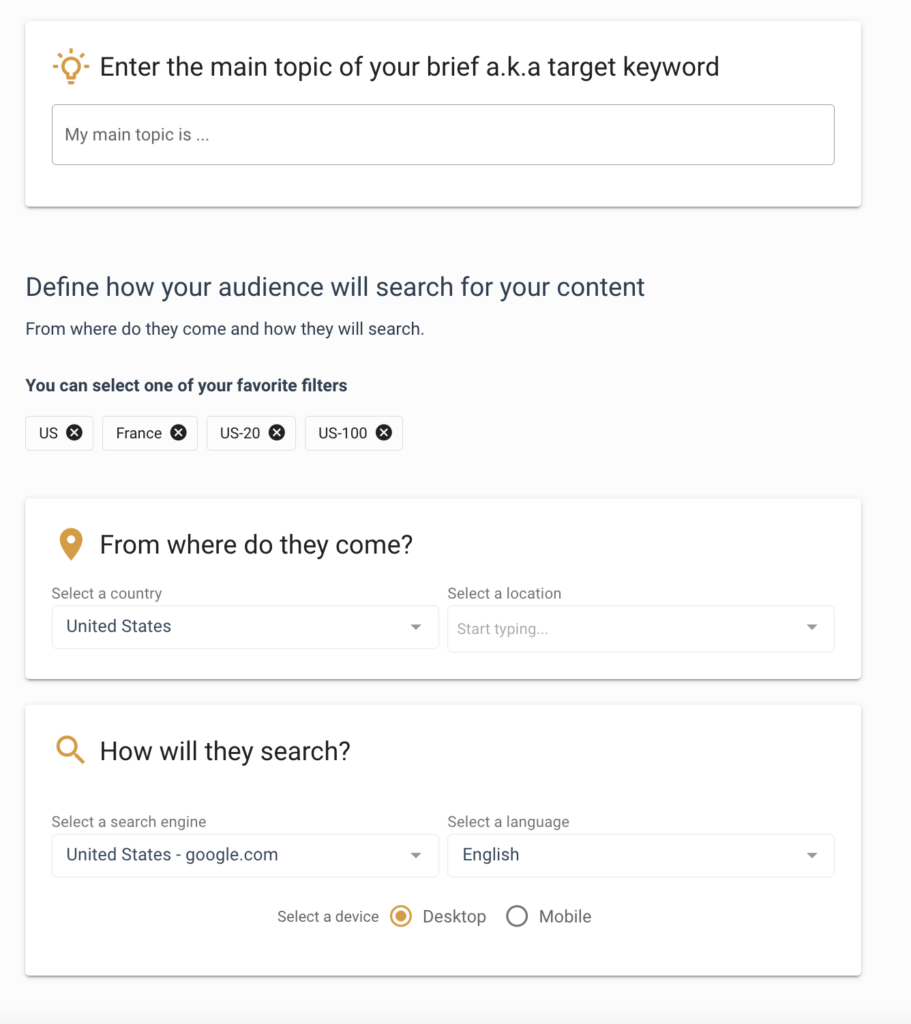
Step 2 – Continue from Pre-filled Information
With thruuu, you won’t start from a blank page. The content brief is automatically filled with various information, you can easily extend them and offer more details to your writer.
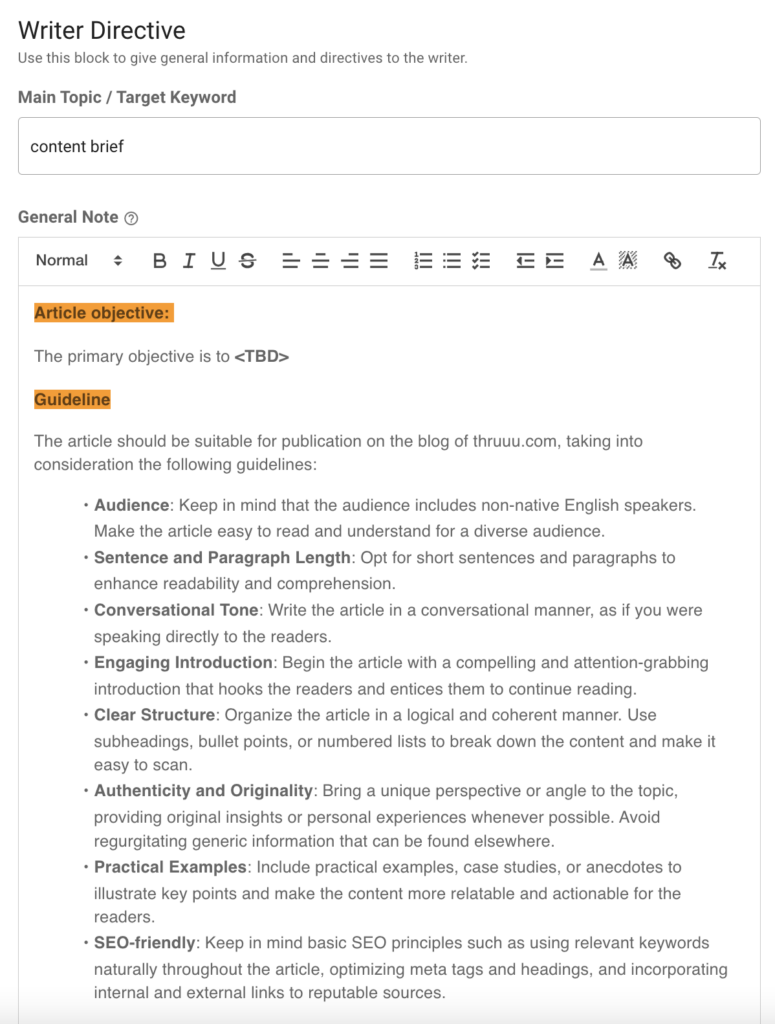
Step 3 – Generate an SEO Title Powered by AI
To accelerate the process, thruuu helps with generating titles, descriptions, and search intent. The tool uses AI together with real-time data from the SERP to offer accurate information.
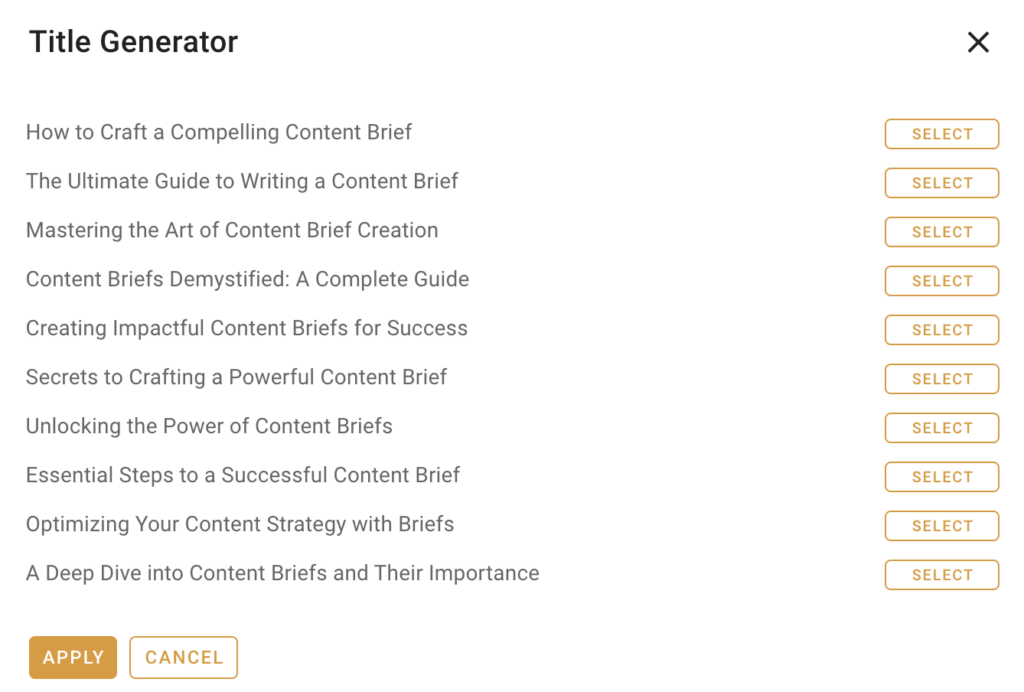
Step 4 – Structure your Headings
Your content outline or heading structure is the centerpiece of your content brief.
It indicates to your writer the structure to follow to create an article optimized for search engine. t
thruuu offers a powerful AI Content Outline Editor where:
- You can generate in 1 click a headings structure following different patterns.
- You can browse your competitors’ outlines and pick their best headings.
- You can access the most frequent headings and questions.
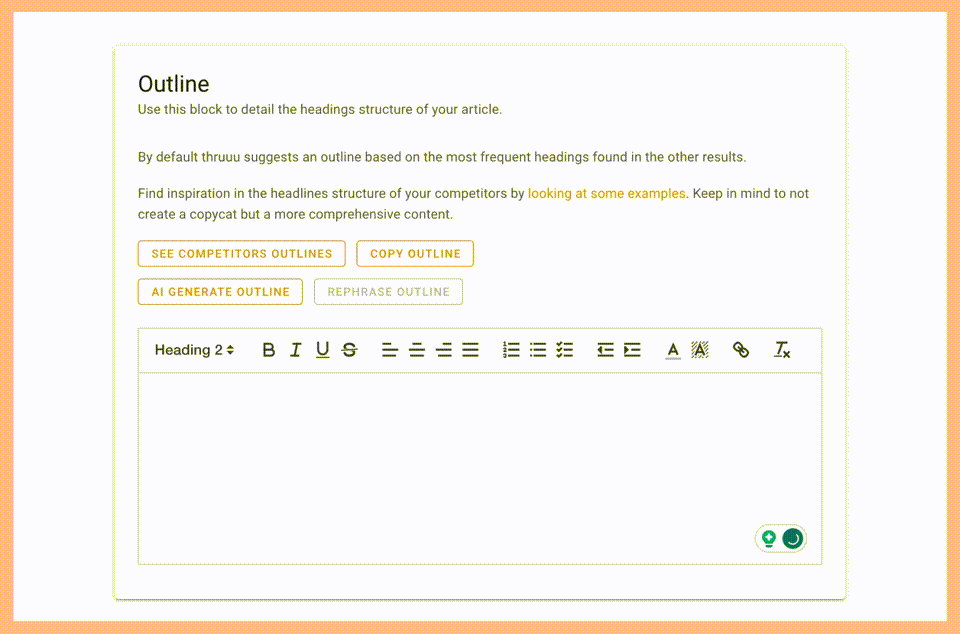
Step 5 – Share the Content Brief with Your Writers
Finally, once your content brief is done, you can share it via a public link with your writer.
Also, you have the option to export the content brief in a Word format.
Below you can see a very comprehensive content brief generated with thruuu.

Empower Your Content Team
Our end-to-end content optimization solution empowers your team to crack the Google algorithm, craft exceptional content, and achieve remarkable organic search results.
